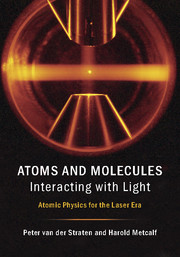Book contents
- Frontmatter
- Contents
- Preface
- Part I Atom–light interaction
- Part II Internal structure
- 7 The hydrogen atom
- 8 Fine structure
- 9 Effects of the nucleus
- 10 The alkali-metal atoms
- 11 Atoms in magnetic fields
- 12 Atoms in electric fields
- 13 Rydberg atoms
- 14 The helium atom
- 15 The periodic system of the elements
- 16 Molecules
- 17 Binding in the hydrogen molecule
- 18 Ultra-cold chemistry
- Part III Applications
- Part IV Appendix
- References
- Index
7 - The hydrogen atom
from Part II - Internal structure
Published online by Cambridge University Press: 05 February 2016
- Frontmatter
- Contents
- Preface
- Part I Atom–light interaction
- Part II Internal structure
- 7 The hydrogen atom
- 8 Fine structure
- 9 Effects of the nucleus
- 10 The alkali-metal atoms
- 11 Atoms in magnetic fields
- 12 Atoms in electric fields
- 13 Rydberg atoms
- 14 The helium atom
- 15 The periodic system of the elements
- 16 Molecules
- 17 Binding in the hydrogen molecule
- 18 Ultra-cold chemistry
- Part III Applications
- Part IV Appendix
- References
- Index
Summary
Introduction
In 1885 Balmer discovered a simple arithmetic relation among the wavelengths of the spectral lines of hydrogen that led to the Rydberg formula. Balmer's formula was later to be found consistent with the Bohr model of the hydrogen atom, and for this reason hydrogen has served as the paradigm for the study of all atoms. The Bohr model serves to describe the energy of electrons in an atom, and also for the study of atoms in external fields, both optical and dc.
It can easily be shown that the behavior of electrons in the atom should be described quantum mechanically, and thus that the Bohr model using semi-classical arguments cannot be definitive. One of the triumphs of the establishment of quantum mechanics in the 1920s was that the Schrödinger equation for hydrogen could be solved exactly. Since the outcome of the theory corresponded completely with the experimental results known at that time, the quantum mechanical description of the hydrogen atom served as one of the first proofs of the validity of quantum mechanics.
The quantum mechanical model of the hydrogen atom is discussed in many textbooks about both quantum mechanics and atomic physics. It is discussed in this book because it serves as the basis for much of the remainder of the book, both in techniques and in notation. Furthermore, hydrogen is the only element (apart from its isotopes and single-electron ions) that can be solved exactly. More important, its solution will be discussed more in terms that are relevant for atomic physics, and not so much in terms of quantum mechanical aspects that are more mathematically oriented.
The system of units used in this book is the internationally accepted SI system. Atomic physics calculations are sometimes very cumbersome in this system, particularly for the internal structure, but for consistency SI units are used in this part as well. This usage is especially important for experimentalists so that formulas can be evaluated in terms of laboratory quantities. The atomic units can be found in App. B.1 at the end of this book.
Information
- Type
- Chapter
- Information
- Atoms and Molecules Interacting with LightAtomic Physics for the Laser Era, pp. 107 - 130Publisher: Cambridge University PressPrint publication year: 2016
